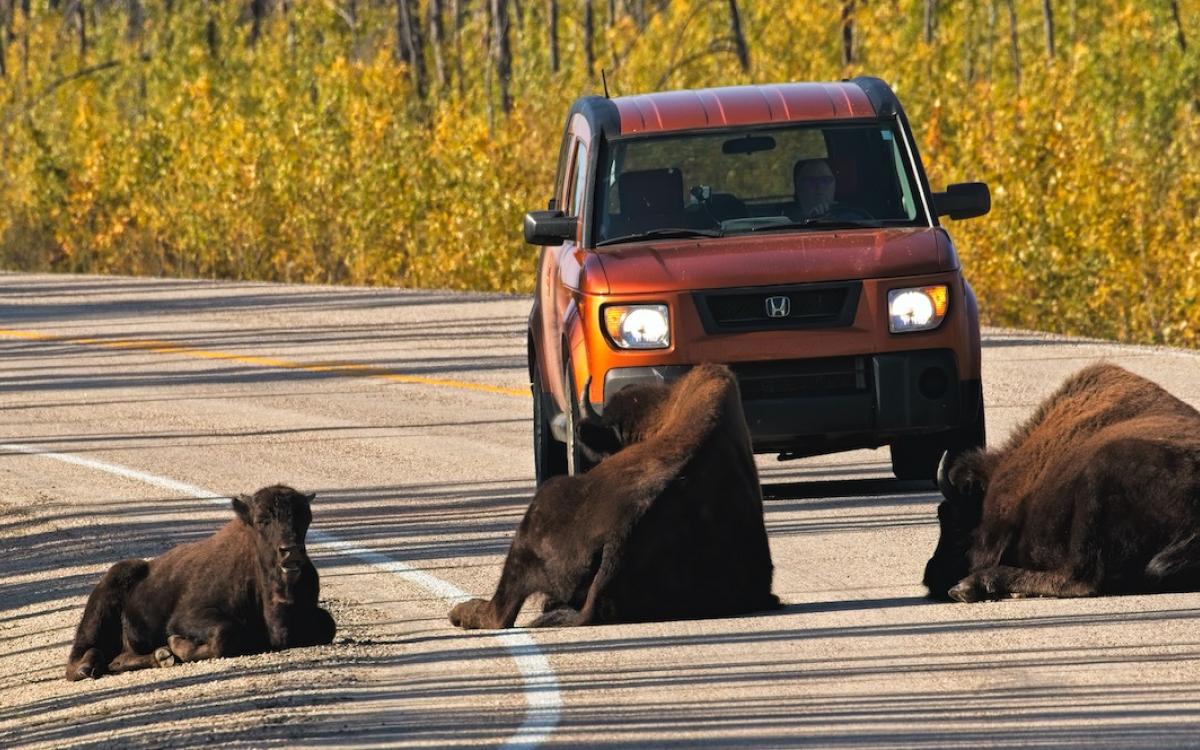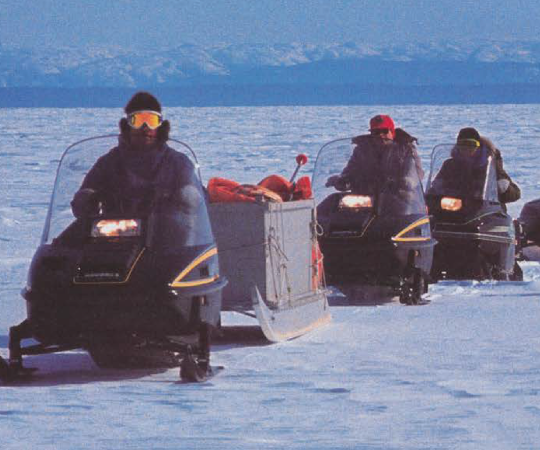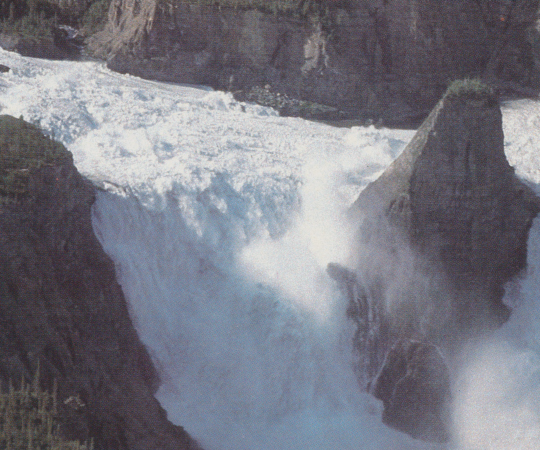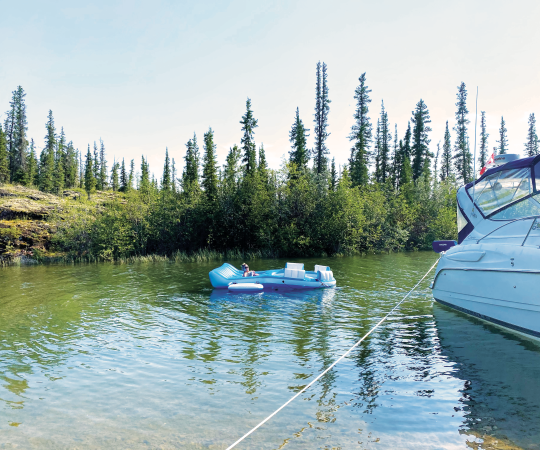We’re driving down the highway towards Yellowknife last summer, when our car screeches to a halt. Standing in the middle of the road is a wood bison—a hulking bull guarding his herd as they cross. We crane our necks out the windows to watch babies snuggling against their mothers and teenagers play fighting along the side of the road, but we’re not going anywhere until the bull says we can. Standing nearly six-feet high at the shoulder and weighing more than a tonne, he’s in charge here.
Humans may have built the roads, but road-tripping in the North takes you into wild territory where we are adamantly not in charge. And that’s part of the adventure. You may be driving from one destination to another, on your way to a festival, an attraction, or a natural marvel, but getting there takes you into land that still belongs to nature. It can be dangerous, it can be tricky, but it’s always exciting.
Bison Barriers
The majority of the world’s wood bison call the Northwest Territories home. Wood Buffalo National Park has the biggest population, around 3,500 bison. Around Fort Providence, about 700 bison live in the Mackenzie Bison Sanctuary. Another 400 can be spotted around Fort Liard, as well. In recent years, the population, once decimated, has started making a comeback, and the animals are now easily spotted while driving through their refuge. Although you can see them year-round, the most dangerous time on the highways is between August and November, and during the July and September mating season where bulls may be extra aggressive. If you spot a herd on the road, keep well back. Bulls have been known to charge vehicles. In 2017, about 157 bison were killed in collisions on the highway, and just last summer two bison (including a calf ) were killed and a Camaro totalled after an accident outside of Fort Smith. Most collisions happen after sunset so be particularly cautious in low light. Bison’s eyes glow red in reflected headlights, so watch out for crimson glows in the forest alongside the road.

Wild Horses
Set out on the Alaska Highway and you’ll have to keep your eyes peeled for the usual northern wildlife... and also herds of feral horses that have been galloping around the territory for almost a century. Although official estimates place the roving equines at only around 100, they make a big impact on traffic—if for no other reason than people pulling over to take photos of pretty ponies. Or, when animal control officers shoot them with paintball guns. Not classified as indigenous wildlife to the territory, the horses aren’t protected like caribou or bears. In 2010, 11 were rounded up and offered for auction or adoption with negligible results. And so management now has mostly focused on keeping them off the road where they can cause traffic accidents—usually with bear bangers to scare them away, and paintballs to mark repeat offenders.
Cars and Caribou
In 2019, the Porcupine caribou herd was spotted along the Dempster Highway for the first time in two years. The herd, about 200,000 animals strong, migrates from Alaska, through the Yukon, before making its way into the Northwest Territories. Watching that summer migration is a marvel that can be done as you move along the Dempster. Just make sure to stay in your car, and give them lots of space. The species is recovering and is best left as undisturbed as possible. Your car also will not win in an encounter with hundreds of caribou.
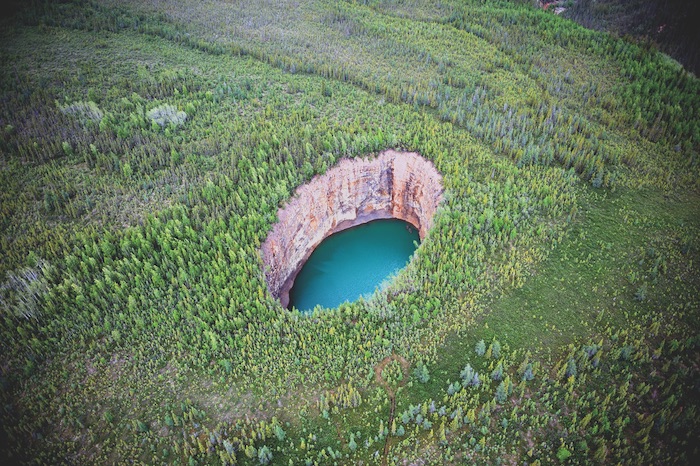
Sunk Costs
Dozens of sinkholes pit the forest between Tulít’a and Norman Wells, including a huge one northwest of Bear Rock that’s full of bright, blue water and thought to be the result of a huge subterranean cave collapse. But in recent years, more and more sinkholes have been popping up—sometimes in less than ideal locations. In 2012, CBC reported that an entire cabin outside of Fort Resolution disappeared into a giant sink hole about 24 by 27 metres in size. A few years before, in 2008, Highway 5 on the way to Fort Smith was closed after a large section of the road collapsed near the Nyarling River. There can be many factors at play, but a warming climate and melting permafrost may be the chief culprits. Check local news reports for highway closures to make sure your car doesn’t take an adventure underground, but older—and therefore stabilized—sinkholes can be beautiful natural wonders worth checking out.
Tuk Highway
The first all-weather road to Canada’s Arctic Coast made headlines when it opened in 2017, as people drove from Inuvik to Tuktoyaktuk to dip a toe in the Arctic Ocean. Since then, travellers have continued to be enamoured by this unique trip through virtually untouched wilderness. But while it might take you just a few hours to complete, don’t think this is a Sunday drive. The road itself is made from loose gravel, which means depending on the weather it can be anything from flying rocks to a mud track. Shifting permafrost also means what was there a week ago may be long gone. Facilities, too, are few and far between. If you really want to go off the beaten track— metaphorically speaking, at least—this is the place to do it. It’s entirely possible not to see another car during the trip. So make sure to have a full-sized spare tire and a jerry can of extra fuel, as well as water and snacks on your journey, just in case. Vehicle selection is key, too. It’s not off-roading, but it’s as close as you can get while still being technically on a road.

